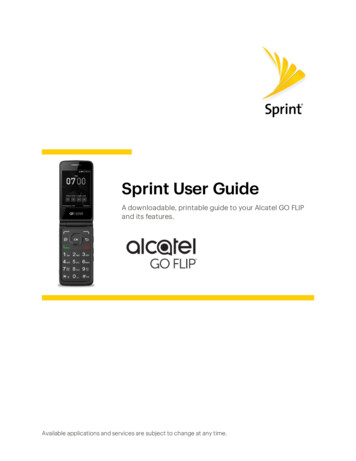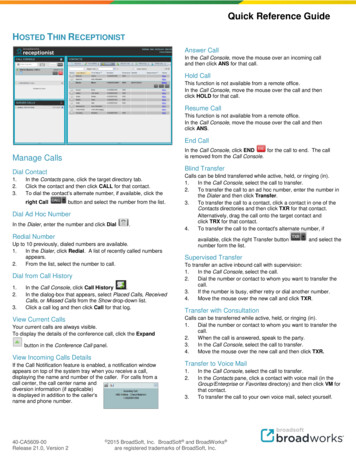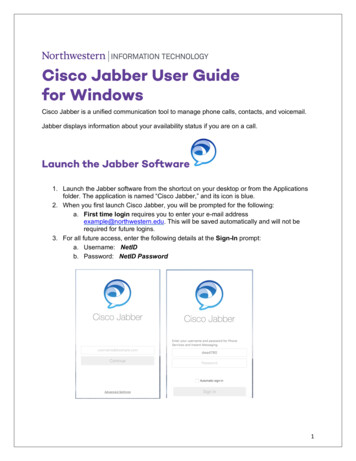
Transcription
The Call Bookfor Team Racing2021 - 2024
First edition: July 2001Seventh edition: January 2021Contact details for the World Sailing Executive Office20 Eastbourne TerracePaddingtonLondon W2 6LGUnited KingdomTelephone: 44 (0) 20 3940 4888Email: office@sailing.org World Sailing LimitedAll rights reserved
ForewordTeam Racing continues to develop as an important part of our sport. Sailed in dinghiesand increasingly in keel-boats, it attracts all ages and experiences, from school andjunior sailors at local events to World and Olympic Champions. Its pinnacle is theWorld Sailing Team Racing World Championships.This Call Book has been developed and refined with input from sailors and umpiresalike due to the need for as much consistency as possible in responding to on the waterprotests. The aim of the Call Book is to help resolve any doubt amongst sailors, judgesand umpires about situations referred to in the Call Book.This latest edition updates calls to maintain consistency with the Racing Rules ofSailing for 2021 – 2024 and also introduces new calls and fine-tunes the existing text.It is important to note that this Call Book, like previous editions, is only authoritativefor Team Racing sailed under RRS Appendix D. This includes racing with and withoutumpires.The World Sailing Racing Rules Committee trusts that competitors, judges andumpires will continue to provide input to the Racing Rules Committee for furtherdevelopment of the Call Book.Readers with comments and suggestions are invited to send them to the World SailingExecutive Office.John DoerrChairWorld Sailing Racing Rules CommitteeDecember 2020
PrefaceThis is the seventh edition of the World Sailing Call Book for Team Racing. It hasbeen edited to reflect the changes in the Racing Rules of Sailing for 2021 – 2024 andin particular the rules of Appendix D. Special thanks to members of the Team RacingRules Working Party: Chris Atkins (GBR), Martin Clasen (GER), Chris Lindsay (IRL),Marta Lloret Llinares (DEN), Rob Overton (USA), Cxema Pico (IRL), Peter Wilson(USA) and Diego Yubero (ESP) for their help in updating this book.Whilst many of the changes are simply changes in references, there are somesignificant game changes involved and sailors and umpires are well advised to studythe new call book in detail! All major changes are a result of a significant rule changeor of a submission to add, delete or change the call.The following is an incomplete list of changes: Calls D2, J9, L5, M7 and M11 have significant changes. Calls H5, J9, J10 and G8 are new but have been previously published in theannual supplement to the call book. Call J10 has significant edits during 2020. Call E11 (previously rapid response call 2018-001) and Call L2 are new. Call E8 is withdrawn for review 8 calls in the previous call book, considered to be duplicates or otherwiseredundant, are deleted. These are C5, E9, E14, H3, L6, L7, M6 and M9. Previous rules 14(b), 21 and 64.1(a) about exoneration are combined into a newrule 43. Consequently all references to exoneration are updated. Significant changes to the umpire process in Appendix D have resulted inchanges to several calls. In addition, there are minor clarifications in many calls and changes to the rulesreferences that do not affect the substance of those calls.The purpose of this call book is to define, for umpires, judges and competitors howincidents will be called in Team Racing.The calls are split into sections associated with progress around the course, citingtypical incidents in the order they are likely to occur and explaining the rules that areapplicable. As a result, some calls are simpler than others, and some include repetitionsfrom earlier explanations. While calls are printed in one section only, this does notmean that they do not apply at other times. Many calls (e.g. those in the prestart section)will apply at all times.Diagrams are limited to 2-dimensional snapshots of each situation. They cannot showwind strength, the waves, the heel and speed of boats and all the many other things thatcontribute to a real-life scenario. They should therefore not be used too literally, butrather as a tool to help recognise quickly and clearly the situation being addressed.
The calls in this book cannot cover every possible incident. As new tactics aredeveloped, new calls will be required. Should reading this call book, or an incident onthe water, stimulate you to comment or propose an additional call, please send an emailto World Sailing at office@sailing.org If there's an incident that you are unsure of,then perhaps it should be written up and submitted as a new call.The publishing of the Call Book is governed by World Sailing regulation 28. Thismeans that it is authoritative for team racing only.World Sailing regulations provide for a system of Rapid Response Team Racing Calls.Calls proposed under this system should be presented in a form similar to existing calls,and sent to the World Sailing office. A call approved as a Rapid Response Call will beimmediately communicated to all IUs, and MNAs. In addition it will be posted on theWorld Sailing website www.sailing.org.The Team Racing Rules Working Party will make recommendations on submitted callsand approved Rapid Response Calls to the Racing Rules Committee.I welcome any comments for improvement of this Call Book.Richard ThompsonChairTeam Racing Rules Working PartyDecember 2020
CONTENTS OF CALL BOOKSection / TopicIntroduction General Principles forUmpire DecisionsA Definitions and FundamentalsB PrestartC The StartD Windward LegE Windward MarkF ReachingGThe RunHThe Gybe MarkJThe Leeward MarkKThe FinishLOther RulesMThe Umpiring ProcessIndex of Rules (in Call Titles)Notes on the text1. With the exception of certain calls in Section M, the calls assume that all flags, hailsand signals (whether by competitors or umpires) have been made in accordance withthe rules.2. Some calls highlight important principles in the rules. For ease of reference, theseclarifications are printed in italics at the end of the call.3. Boat shading is used to differentiate between teams. Boats A, B, C are shaded greyand are on one team, and X, Y, Z are white and are on the other. A few calls showboats in colour when B will be blue, Y will be yellow and any third boat will begreen; the text will identify team-mates. When only two boats are involved they willnormally be named B and Y.4. These calls apply to all team racing formats when Appendix D applies, regardless ofthe number of boats on each side. Only boats shown in a diagram or described inthe text are involved in the incident; other boats in the race are not relevant to thecall and are not shown.5. When boats are already overlapped at position 1 in a call, the phrase 'Rule 17 doesnot apply to Y' is used to show that Y may sail above her proper course. Thealternative is 'Y is subject to rule 17’.6. Unless otherwise indicated, the wind is blowing from the top of the diagram.7. The calls refer to 'umpires' making decisions. Whilst it is normal to have twoumpires in an umpire boat, there is no requirement for this and the calls apply equallywhen there is only one umpire. When appendix D applies, the calls also apply atprotest committee hearings; see World Sailing regulation 28.3.
GENERAL PRINCIPLES FOR UMPIRE DECISIONSThe following general principles apply to umpire decisions:1.'Last Point of Certainty'There are many occasions when umpires are required to judge (often from imperfectpositions) the exact moment when the state of a boat, or her relationship with anotherboat, changes. Examples include passing head to wind or establishing an overlap.In such cases the umpires will assume this state or relationship has not changed untilthey are certain that it has changed.2.Disagreement between UmpiresThere are occasions when umpires disagree over what the decision should be. In suchcases, even if there has been contact, the umpires will signal 'no penalty' rather thanpenalize one boat or the other.3.Rule 14: Avoiding ContactAny incident involving contact will also involve rule 14. However, when the umpiresdecide that a boat required to keep clear or give room is to be penalized for breakinganother rule of Part 2, a breach of rule 14 will not result in an additional penalty unlessthere is damage. Except in this case, rule 14 has no impact on the immediate umpiredecision, and is therefore not addressed separately in each call in this book.4.Definition: Room, and meaning of 'in a seamanlike way'World Sailing Case 21 states that ‘extraordinary’ and ‘abnormal’ manoeuvres areunseamanlike. Some actions that are abnormal and therefore unseamanlike in a fleet ofmany boats will be considered normal and therefore seamanlike in a team race.However, any manoeuvre that puts a boat or crew at risk of damage is unseamanlike.The umpires will judge each incident on the basis of the boat’s actions in relation tothe wind and water conditions she is experiencing at the time.5.Advantage Gained after Breaking a RuleWhen a boat breaks a rule and she, or another boat on her team, takes a penalty, theumpires will decide if the boat's team has gained an advantage despite the penaltytaken. If so, they will act under rule D2.3(c). Except for some calls in Section M, thisis not addressed separately in each call in this book.
TR CALL A1Rule 13Rule 17While TackingOn the Same Tack; Proper CourseQuestionOn a beat to windward, an overlap is established while one boat is tacking or shortlythereafter. Under which of the following conditions is B, the leeward boat, permittedto sail above her proper course?Figure 1Figure 2Y4Y3Y2B3Y2B4Figure 3Y3Y3B3Y1Y2B2B3B2Y1B1B2B1Y1AnswerFigure 1: Overlap established from clear astern - B does not acquire luffing rights. Ycompletes her tack at position 3, when she is clear ahead of B. Shortlythereafter B establishes an overlap from clear astern and will break rule 17if she sails above her proper course during this overlap, and while the boatsremain within two hull lengths of each other, unless in doing so shepromptly sails astern of Y.Figure 2: Overlap established from clear astern - B acquires luffing rights. Themoment Y passes head to wind in position 2 the boats are on the same tack,but not overlapped. The overlap is established before Y reaches a closehauled course - i.e. while Y is subject to rule 13. Therefore rule 17 does notapply and B may sail above her proper course.Figure 3: Overlap established 'instantaneously'. At position 2, when B passes throughhead to wind, both boats are on the same tack and overlapped. As neitherboat established this overlap from clear astern, the overlap is said to be'instantaneous'. Rule 17 does not apply and B may sail above her propercourse.Section A - Definitions and Fundamentals
A tacking boat changes tack the moment she passes head to wind. However, she iskeep-clear boat subject to rule 13 from the moment she passes head to wind until sheis on a close-hauled course. If another boat becomes overlapped to leeward of herfrom clear astern during that period, rule 17 does not apply and the leeward boat maysail above her proper course - i.e. she has 'luffing rights'.Section A - Definitions and Fundamentals
TR CALL A2Rule 11DefinitionsOn the Same Tack, OverlappedKeep ClearQuestionB closes on Y from windward. When is B no longer keeping clear of Y?B1B2B3B4Y4Y3Y2Y1AnswerB is keeping clear of Y when Y, the right-of-way boat, can sail her course with no needto take avoiding action and also, because they are overlapped, change course in bothdirections without immediately making contact.At positions 1 & 2: B is keeping clear.At position 3:if Y luffs, there will be contact but not immediately, so B is stillkeeping clear.At position 4:Y cannot change course to windward without immediately makingcontact with B. B is no longer keeping clear, and would bepenalized under rule 11 if Y were to protest, whether or not theboats make contact.At any moment, a boat’s course (as that term is used in Part 2 and the Definitions)means the direction in which her bow is pointing. It does not mean her proper course,nor the course she could be expected to be sailing shortly.There does not need to be contact for a boat to fail to keep clear.Section A - Definitions and Fundamentals
TR CALL A3Rule 11Rule 16.1DefinitionsOn the Same Tack, OverlappedChanging CourseKeep ClearQuestionY and B are overlapped, sailing parallel courses, with about ½ boat’s width betweenthem. Y has no proper course restriction. Just before position 3 Y luffs slowly and Bpromptly responds. Y continues to luff and there is no longer any means of B avoidingY. B tries to keep clear by luffing and there is contact. Y protests. What should the callbe?AnswerPositions 1 and 2: B is keeping clear because she is sufficiently far from Y that Y isable to change course in both directions without immediatelymaking contact.Position 3:After Y’s first change of course, B still has room to keep clear. Bmust, promptly and in a seamanlike way, do whatever she can toestablish sufficient distance between her and Y so that she iskeeping clear. If B does this she is protected by rule 16.1.Between 3 and 4: Y continues to change course, and B is no longer able to keep clear.Y breaks rule 16.1. Penalize Y.If Y continues to luff and B continues to respond promptly and in a seamanlike way toeach luff, Y will ultimately have to stop luffing when the boats are so close that anyfurther luff from Y will result in B being unable to keep clear. If Y does stop luffing atsuch a time, and B continues to respond to keep clear, neither boat breaks a rule.A boat that is required to keep clear must promptly take any opportunity to keep clearwhen a right-of-way boat changes course, but does not normally have to anticipate anychange of course by a right-of-way boat.Section A - Definitions and Fundamentals
TR CALL A4Rule 11Rule 16.1Rule 43Rule D2.3DefinitionsOn the Same Tack, OverlappedChanging CourseExonerationPenalties Initiated by an UmpireKeep ClearQuestionY and B are small dinghies sailing to windward with a small gap between them. Asquall hits the boats and Y’s crew leans out, touching B’s leeward gunwale with hisbody. B protests. What should the call be?B2Y2B1Y1AnswerPenalize B under rule 11. Boat Y does not change course. Y’s actions are consistentwith seamanlike sailing in the existing conditions, and B fails to meet her obligationsas keep clear boat.If Y’s actions are inconsistent with seamanlike sailing in the existing conditions, andare solely designed to cause contact, penalize Y in accordance with rule D2.3(g) for abreach of sportsmanship and exonerate B under rule 43.1(a).(See also World Sailing cases 73 and 74.)A boat changes course when she changes her compass bearing. Leaning out, slowing,and heeling the boat are not changing course.Section A - Definitions and Fundamentals
TR CALL A5Rule 11Rule 16.1DefinitionsOn the Same Tack, OverlappedChanging CourseKeep ClearQuestionB and Y are sailing parallel courses with very little distance between them. Y bearsaway and her stern hits B. Y protests. What should the call be?B2Y2B1Y1AnswerThe umpires will consider how close two boats may sail in the prevailing conditionssuch that the leeward boat can both luff and bear away without immediately makingcontact with the windward boat, and also how the two boats came to be this close.Case 1: When B has had an opportunity to keep clear but is sailing so close to Y thatany luff or bear away by Y will immediately result in contact, B fails to keepclear and breaks rule 11. Penalize B.Case 2: If B is not keeping clear, but the boats came to be this close as a result of Y'searlier alteration of course, to which B responded promptly, and B has sincenot had an opportunity to increase the distance between the boats, then Ybreaks rule 16.1. Penalize Y.Case 3: If B is keeping clear and Y bears away hard, then Y does not give B room tokeep clear and therefore breaks rule 16.1. Penalize Y.Section A - Definitions and Fundamentals
TR CALL A6Rule 11Rule 18.1Rule 18.2Rule 43DefinitionsOn the Same Tack, OverlappedWhen Rule 18 AppliesGiving Mark-RoomExonerationMark-Room, ZoneQuestion 1Y and B are approaching a mark to be left as indicated by the arrows. Rule 17 does notapply to B. What is the latest time B may luff?WINDYWINDBYBAnswer 1Rule 18 begins to apply when any part of the hull of either boat is in the zone. Fromthis moment, if B luffs and thereafter has to bear away in order to give Y mark-room,then B breaks rule 18.2. B does not break rule 18.2 if she is able to luff while giving Yroom to sail to the mark as required by paragraph (a) in the definition Mark-Room. Yis required to keep clear under rule 11. However, she will be exonerated under rule43.1(b) if she breaks rule 11 because B fails to give her mark-room.Question 2If B has to bear away to give mark-room, when is she required to do so?Answer 2B is required to bear away promptly when the first of the boats enters the zone.Section A - Definitions and Fundamentals
TR CALL B1Rule 11Rule 15Rule 43On the Same Tack, OverlappedAcquiring Right of WayExonerationQuestionBefore the start, Y is sailing slowly and B establishes an overlap from clear astern. Atthe time the overlap is established Y can keep clear by maintaining her course andaccelerating. Instead Y delays her response and then luffs, and her stern hits B. Thereis a protest. What should the call be?Y3B3Y2Y1B2B1AnswerPenalize Y. When B gains her overlap she must initially give Y room to keep clear. Bfulfils her obligations under rule 15, because, when the overlap is established, Y cankeep clear by maintaining her course and accelerating, or by luffing. However, whenY delays her response, and then elects to luff and there is contact, she fails to keepclear. Y breaks rule 11.When a keep-clear boat reacts appropriately and in a timely manner, but is unable tokeep clear, the right-of-way boat fails to give room and will be penalized for breakingrule 15. The other boat will be exonerated under rule 43.1(b).When a keep clear boat reacts slowly, or in an inappropriate manner, and then fails tokeep clear, the keep clear boat will be penalized for failing to keep clear.When one boat acquires right of way, the other boat must promptly take appropriateaction to try to keep clear. Depending on the circumstances, this action may includeaccelerating or tacking.Section B – The Prestart
TR CALL B2Rule 11Rule 13Rule16.1DefinitionsOn the Same Tack, OverlappedWhile TackingChanging CourseKeep ClearQuestion 1Boats B and Y are overlapped and B, the windward boat, is keeping clear. Y luffs headto wind, B luffs in response, and both reach head to wind, side by side. B continues tochange course and passes through head to wind. As a result B makes contact with Y.There is a protest. What should the call be?QUESTION 1Y4B4B3Y3B2Y2B1Y1Answer 1When Y luffs, if she fails to give B room to respond and keep clear, penalize Y.If B could have kept clear, but either responds too slowly or not enough, or overrotates, then B breaks rule 11 or 13. Penalize B.Question 2In similar circumstances, Y luffs without breaking rule 16 and B responds. When headto wind B maintains this position when she could have tacked off. Slightly later Y bearsaway and their sterns make contact. There is a protest. What should the call be?Section B – The Prestart
QUESTION 3QUESTION 2Y4Y3Y2B4Y4B3Y3B2Y2B4B3B2B1B1Y1Y1Answer 2If Y’s change of course immediately results in contact with B, then B was not keepingclear and broke rule 11. Penalize B.If there is a greater distance between them, and Y bears away hard without giving Broom to keep clear, then Y breaks rule 16.1. Penalize Y.Question 3In similar circumstances B keeps clear but, when she reaches head to wind, shemaintains this position for a while. B then passes through head to wind and, slightlylater, Y bears away and their sterns make contact. There is a protest. What should thecall be?Answer 3When B passes head to wind, the boats are no longer overlapped on the same tack soparagraph (b) of the definition Keep Clear no longer applies.If the contact would have occurred without Y bearing away, B breaks rule 13. PenalizeB.If the contact would not have occurred without Y bearing away, Y breaks rule 16.1.Penalize Y.Section B – The Prestart
TR CALL B3Rule 12Rule 15Rule 16.1On the Same Tack, Not OverlappedAcquiring Right of WayChanging CourseQuestion 1Before the start, B and Y are both on port tack, with B clear astern of Y. As Y bearsaway to gybe, B also bears away onto a course that will become a collision course if Ybears away further. At no time during the manoeuvre are the boats overlapped. Y luffsand protests. What should the call be?Y1B1B2Y2B3B4Y3Y4Answer 1No penalty. As right-of-way boat Y is required to give B room to keep clear when shechanges course. B is required to keep clear, so she must not prevent Y from sailing inthe direction she is pointing. At position 3 B is keeping clear, but her actions arepreventing Y from bearing away further. Neither boat breaks a rule.Question 2If an overlap is established just after position 3, does the situation change?Answer 2Just after position 3, B becomes right-of-way boat at least in part because of Y’sactions. Therefore, provided she maintains her course, B does not initially need to giveY room to keep clear. As Y keeps clear she breaks no rule. No penalty.Section B – The Prestart
TR CALL B4Rule 13Rule 16.1While TackingChanging CourseQuestion 1B and Y are separated and not on a collision course. B intends to tack but after passinghead to wind she loses way. Before B is on a close-hauled course, Y bears away ontoa collision course with B. B is unable to take any avoiding action that would preventcontact if Y were to stop bearing away. However, Y bears away continuously andpasses astern of B. Y protests. What should the call be?Y2B4Y1Y3B3B2Y4B1Answer 1No penalty. Y’s change of course at position 1 requires her to give B room to keepclear (rule 16.1). Because B has lost way, she does not have room to keep clear if Ymaintains her course. Y complies with rule 16.1 by bearing away further.Question 2Will the answer change if B’s helmsman intentionally loses steerage and places theboat in a situation where it will be impossible to keep clear if Y changes to a collisioncourse?Answer 2No. Whether or not she does so deliberately, no rule prohibits B from being in theposition she is in here, or requires her to anticipate Y’s change of course.A right-of-way boat changing course may comply with rule 16.1 by changing coursefurther and thus giving the other boat room to keep clear. (See also Call D3.)[There is no call B5]Section B – The Prestart
TR CALL B6Rule 10Rule 15On Opposite TacksAcquiring Right of WayQuestionBefore the start Y and B, reaching on starboard tack, approach an anchored boat. WhenY reaches the anchored boat, she is clear ahead of B. Y passes to windward of it, bearsaway alongside it, then gybes in order to sail around its stern. Very soon after Y gybes,B is still on starboard and gains a small inside overlap. B changes course trying toavoid contact with Y but there is contact. There is a protest. What should the call be?B1Y1B2Y2B3Y3AnswerPenalize Y.When Y gybes in position 2, she gives up right-of-way. Therefore rule 15 does notapply. In position 3 Y fails to keep clear of B and breaks rule 10.Section B – The Prestart
TR CALL B7Rule 20Room to Tack at an ObstructionQuestion 1Before the start B and Y are sailing close-hauled towards a pontoon. B calls for roomto tack. Y replies 'No, you can go inside'. B protests. What should the call be?QUESTION 1YBAnswer 1Penalize Y. Rule 20.1 allows B to hail for room to tack to avoid the obstruction. Whenhailed, Y fails to respond as required by rule 20.2(c).Question 2The situation is the same except that B by luffing slightly is able to avoid the pontoon.B calls for room to tack. Y replies 'No, you can luff slightly'. B does this and protests.What should the call be?QUESTION 2YBAnswer 2Penalize both boats. Rule 20.2(b) requires Y to act in response to the hail even if thehail breaks rule 20.1. By not doing so she breaks rule 20.2(b). In addition, because Bdoes not need to make a substantial course change to avoid the pontoon, B breaks rule20.1(a) by hailing for room to tack.If instead Y tacks and protests, then B breaks rule 20.1(a) and Y breaks no rule.A boat hailed under rule 20.1 must act as if the hail is valid even if she believes it tobe invalid. If she does not, she breaks rule 20.2(b).A boat hailing under rule 20.1, when not entitled to do so, breaks rule 20.1.[There is no call B8]Section B – The Prestart
TR CALL B9Rule 21.3Moving AsternQuestionShortly before the start, B and Y are sailing ahead very slowly, Y half a length aheadof B. Y is in danger of crossing the starting line before the start and briefly backs hermainsail. This causes her to sail backwards toward B. She then stops backing her sailbut continues to move backwards towards B. B maintains her position, and there iscontact. B protests. What should the call be?Y1Y2Y3B3B2B1AnswerPenalize Y.Rule 21.3 requires a boat moving astern by backing a sail to keep clear of one that isnot. Although Y is no longer backing her sail, she is moving astern because she backedher sail, and is still subject to rule 21.3. Y fails to keep clear and breaks rule 21.3.A boat is 'moving astern by backing a sail' and therefore subject to rule 21.3 if she ismoving astern through the water, and she initiated or assisted her sternwards motionby backing her sail. If she ceases to back the sail, but is still moving astern, she is stillsubject to the rule.Section B – The Prestart
TR CALL C1Rule 11Rule 16.1Rule 17Part 2Same Tack, OverlappedChanging CourseOn the Same Tack; Proper CourseSection C, Preamble, When Rules do not ApplyQuestionBefore the starting signal Y establishes an overlap from clear astern to leeward of Band A. After the start Y luffs above close-hauled to pass the leeward starting mark. Bimmediately luffs to try to keep clear, but makes contact with team-mate A who is alsotrying to keep clear. A protests. What should the call be?Y3Y2AY1BAnswerRule 18 does not apply at a starting mark when boats are approaching it to start (Part 2Section C Preamble). Because Y establishes the overlap from clear astern within twoof her hull lengths, she may not sail above her proper course after the starting signal.(A boat has no proper course before the starting signal.) In this case Y’s proper courseis to luff to pass the mark. Provided Y complies with rule 16.1 when she luffs, Y doesnot break a rule.Rule 16.1 requires that, when Y changes course, she must give B and A room to keepclear. If A was keeping clear of B, but is now unable to do so because of B’s luff tokeep clear of Y, then Y's alteration of course breaks rule 16.1. Penalize Y.However, if A is so close to B that she is not keeping clear when Y starts to luff, or ifA responds late or not enough when B changes course to keep clear of Y, then A failsto keep clear and breaks rule 11. Penalize A.When a right-of-way boat subject to rule 16.1 changes course, she must give any otherboat affected by this change of course room to keep clear.Section C - The Start
TR CALL C2Rule 11Rule 16.1Part 2On the Same Tack, OverlappedChanging CourseSection C, Preamble, When Rules do not ApplyQuestion 1Y and B are approaching the starting line to start with Y clear ahead and to leeward ofB. B establishes an overlap to windward between Y and the committee boat. Atposition 3 Y luffs, hailing 'No room'. B responds to the luff, and in so doing makescontact with the committee boat. B protests. What should the call be?QUESTION 1QUESTION 2B3B3Y3Y3B2B2B1Y2Y2B1Y1Y1Answer 1The Part 2 Section C Preamble states that neither rule 18 nor rule 19 applies when boatsare approaching a starting mark to start. Y is therefore not required to give B room topass the committee boat. However, rule 16.1 requires Y to give B room to keep clearwhen she changes course. When Y changes course after position 2 she fails to give Broom to keep clear. Penalize Y.Question 2If Y’s alteration of course occurs after position 1, and as a result B passes the wrongside of the committee boat, what should the call be?Answer 2Provided she reacts promptly, B can still keep clear by passing the wrong side of thecommittee boat. Y therefore does not break rule 16.1. No penalty.If B does not respond promptly to the luff and then fails to keep clear, she breaks rule11. Penalize B.Section C - The Start
TR CALL C3Rule 21.1Rule 23.2Starting ErrorsInterfering with Another BoatQuestionAfter the start, B is sailing on port tack towards the pre-start side of the starting linewithout having started. Y has started correctly and bears away below her proper courseonto a collision course with B. B gybes and keeps clear of Y. B protests. What shouldthe call be?AnswerPenalize Y. At position 1, B is keeping clear of Y as required by rule 21.1. When Ybears away after position 1 she breaks rule 23.2 as she is no longer sailing her propercourse and she interferes with B, a boat subject to rule 21.1.After the starting signal, if a boat is sailing towards the pre-start side of the line, theumpires will use the principle of the ‘last point of certainty’ and decide the boat hasnot started, unless they are certain that she has started.Section C - The Start
TR CALL C4Rule 11Rule 16.1Rule 17On the Same Tack, OverlappedChanging CourseOn the Same Tack; Proper CourseQuestion 1Before the starting signal Y establishes an overlap to leeward of B from clear astern.After the starting signal both boats continue on starboard tack, and at all times B iskeeping clear. About one minute after starting Y is beginning to draw ahead, althoughthe boats are still overlapped. Y heels to windward and luffs above close-hauled. Bprotests. What should the call be?Y4B4B
annual supplement to the call book. Call J10 has significant edits during 2020. Call E11 (previously rapid response call 2018-001) and Call L2 are new. Call E8 is withdrawn for review 8 calls in the previous call book, considered to be duplicates or otherwise redundant, are deleted. These are C5, E9, E14, H3, L6, L7, M6 and M9.










